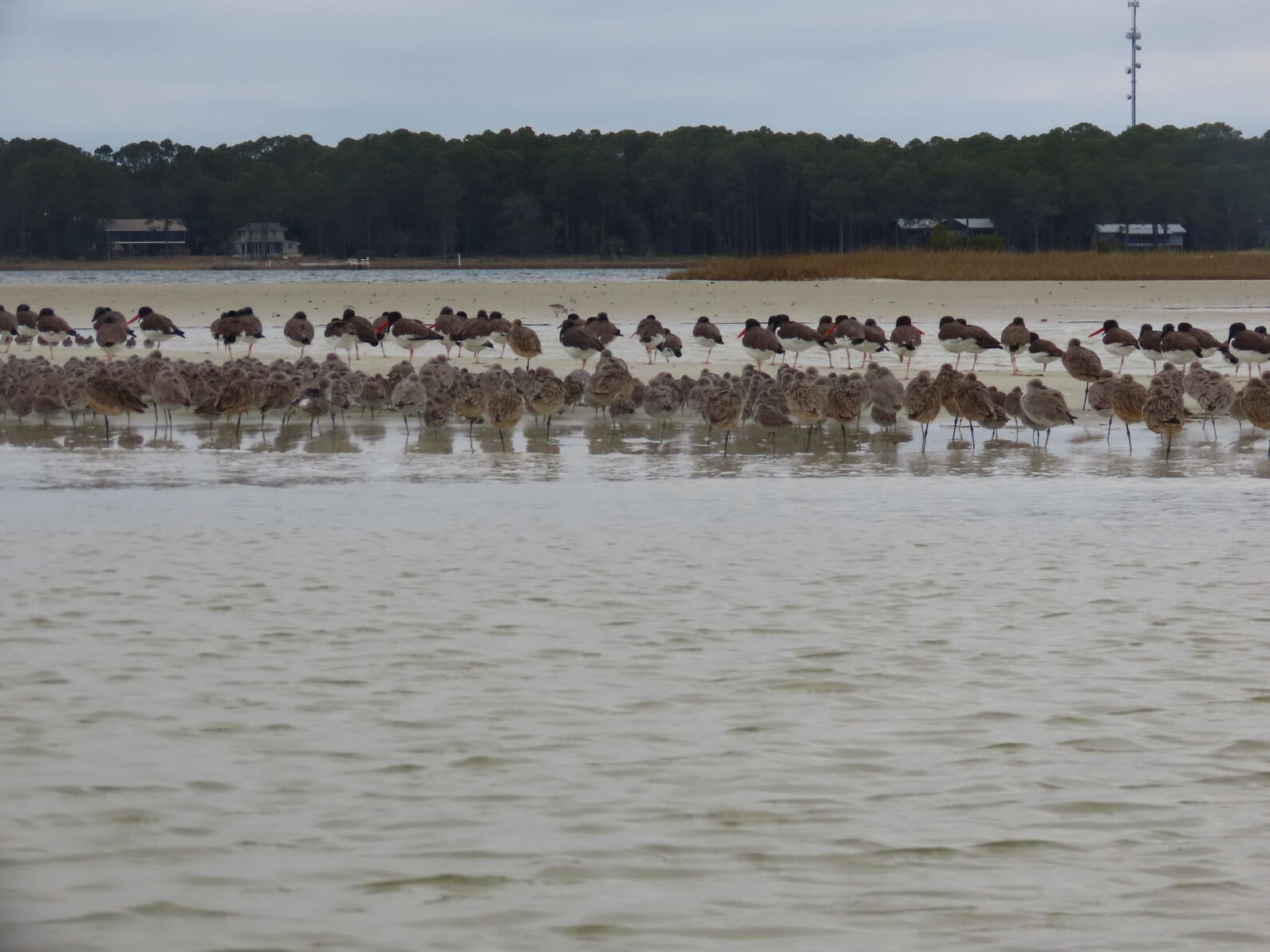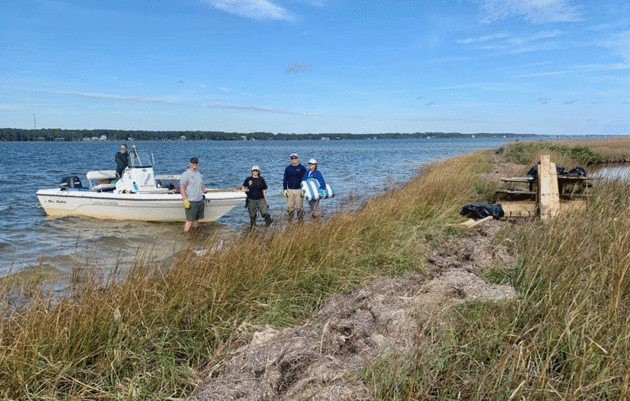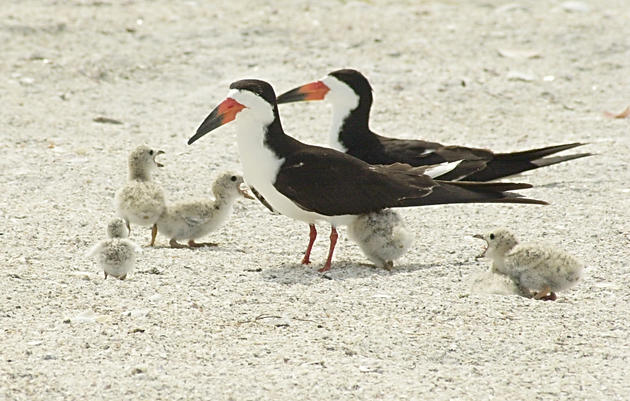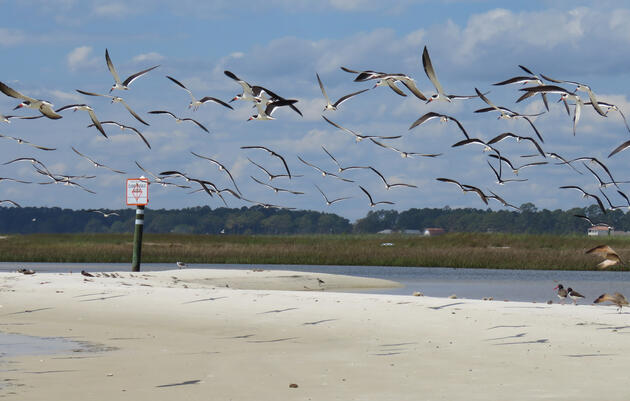Off the coast of Franklin County in the Florida Panhandle lies an Audubon property that has become a year-round hotspot for both sea and shorebirds: Lanark Reef.
What is Lanark Reef?
Lanark Reef is a two-mile long string of sandy vegetated islands surrounded by marshes and mud flats. The highest point on the site sits less than ten feet above the high tide line, making it prone to over-washing. During low tides, the site grows in size as the drop in water level exposes a vast expanse of sandbars and seagrass beds that are perfect for foraging shorebirds and roosting seabirds. This expanse attracts Marbled Godwits, Short-billed Dowitchers, Willets, and Laughing Gulls in densities that are rarely seen anywhere else in the state.
While there are a large number of shorebirds and seabirds at the site, the high number of nesting and non-breeding American Oystercatchers is the primary reason for ongoing protection of Lanark Reef. This past year there were 13 nesting pairs of oystercatchers, and during the winter we documented over 120 non-breeding American Oystercatchers, making Lanark Reef a location of international importance to shorebirds.
Since the site is nearly a mile away from the mainland, most mammalian predators can’t reach Lanark Reef. The main predators at the site include Fish Crows, Laughing Gulls, Great Horned Owls, fire ants, and small mammals.

Why is Protecting Lanark Reef Important?
Lanark Reef is a piece of a larger conservation network, as 80 percent of the county is protected. Included in this conservation network are five Critical Wildlife Areas (CWA) -including Lanark Reef - that protect nesting shorebirds and seabirds and their habitat. The site’s CWA status prohibits boats and people from entering, the area posted with signs that stand guard in the water surrounding the site. Lanark Reef’s protection is critical for these birds, as even small disturbances in the breeding season can leave nests and chicks vulnerable to predators. The CWA designation further means that the Florida Fish and Wildlife Conservation Commission (FWC) assists Audubon Florida staff with managing the site.
What is Audubon’s Role on Lanark Reef?
Audubon staff visit Lanark Reef weekly throughout the spring and summer to monitor nesting bird activity and bi-weekly during the fall and winter seasons to monitor non-breeding birds and banded birds. These surveys provide data to the FWC, which is then used to defend the importance of the CWA designation, influence law enforcement time at the site, as well as influence management in the area. In recent years, FWC staff have been making an effort to band American Oystercatchers and chicks to understand bird survival, nest survival, and regional movement of these birds. Through regular site visits and using cameras, we are able to pinpoint sources of predation and nest failure, which has been a problem at the site.
What Other Birds Make Their Home Here?
Along with state-Threatened American Oystercatchers, state-Threatened Least Terns and Black Skimmers also nest at Lanark Reef, while state-Threatened Snowy Plover and federally-Threatened Red Knots winter at the site. The US Fish and Wildlife Service has designated the site as critical habitat for Piping Plovers, another shorebird species with special conservation status. Wading birds, seabirds, and shorebirds that nest at the site include: Sandwich Terns, Royal Terns, Great Egrets, Tricolored Herons, Brown Pelicans, Willets, and Laughing Gulls.
How Did the 2021 Summer Breeding Season Go?
The 2021 breeding season proved successful, with all nesting species fledging chicks. For the first time in nine years, a flight-capable American Oystercatcher chick successfully fledged and was documented at another site.
Laughing Gulls also had a great year at Lanark Reef, and we recorded more than 500 fledges at the site in early July. In 2021, Audubon monitored 50 pairs of nesting Black Skimmers, 50 pairs of Royal Terns, six pairs of Gull-billed Terns, and 30 pairs of Sandwich Terns.
While this year was a resounding success at Lanark Reef, the conditions are constantly changing, and Audubon and FWC staff are constantly adapting our management strategies to give the birds the ability to be as successful as possible.

What Can I Do to Help the Birds?
Since Lanark Reef is closed to public access - for those who live in the area or pass by the area, if you see activity within the Critical Wildlife Area boundaries please call the FWC. There are very few people who are allowed to access the site and if they are allowed to access, FWC will know they are out there.
Additionally, Audubon's coastal team runs a stewardship program throughout the state to help keep track of human activities at sites with beach nesting birds. In particular, Franklin county has a few sites with active stewarding programs including Phipps Preserve, Bald Point State Park, and St. George Island State Park. Stewarding at Lanark Reef can be done by boat or kayak from outside the Critical Wildlife Area boundaries. Click here for more information about how to get involved with Audubon Florida’s coastal stewardship program.







